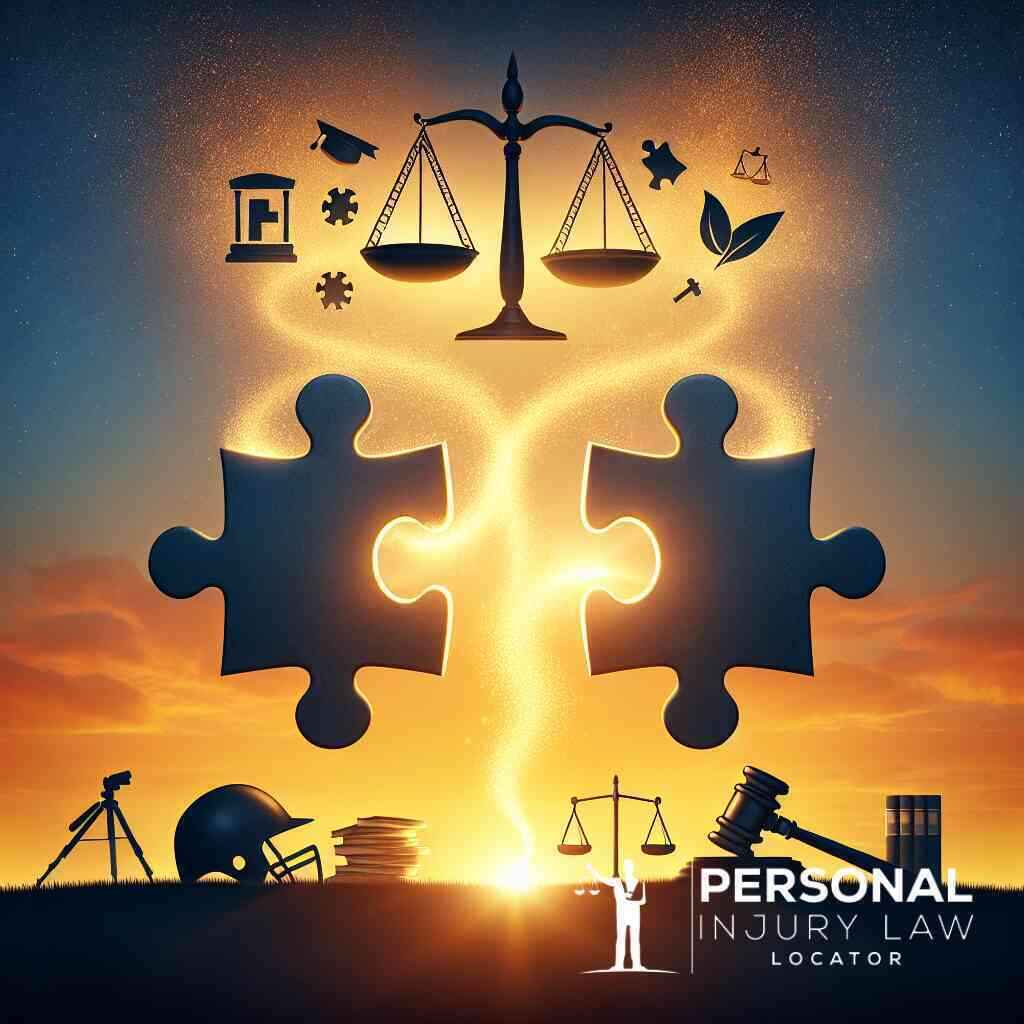 Posted On: 08/29/2024
Posted On: 08/29/2024Unveiling the Core: Understanding Negligence and Liability in Personal Injury Law
Definition of Negligence in Personal Injury Law
Negligence, a fundamental concept in personal injury law, refers to the failure to exercise the level of care that a reasonably prudent person would under similar circumstances. This legal principle is critical because it establishes the standard for determining fault in personal injury cases. When someone acts in a way that deviates from how a cautious individual would behave, causing harm to another person, negligence is at play. Understanding negligence is pivotal for anyone pursuing a personal injury claim, as it directly impacts the ability to recover damages for injuries sustained.
Definition of Liability: The Legal Responsibility
Liability, in contrast, pertains to the legal responsibility one party has in the compensation of damages experienced by another. In the realm of personal injury law, establishing liability means proving that the party at fault legally owes compensation to the injured person for the losses incurred. This can result from direct actions, such as in a car accident where one driver’s negligence causes injury to another, or through indirect means, such as when an employer is held liable for the negligent actions of an employee. The concept of liability is what bridges the gap between proving negligence and receiving compensation.
Negligence vs. Liability: The Foundation of Personal Injury Claims
Negligence and liability are the twin pillars supporting personal injury claims, yet they serve distinct roles in the legal process. Understanding the difference between negligence and liability is crucial for anyone involved in a personal injury case. Negligence pertains to conduct that breaches the duty of care, leading to harm. Liability, however, is concerned with the legal obligation to remedy the damage caused.
In essence, while negligence focuses on the behavior leading to damage, liability concerns the legal ramifications of that behavior. For a successful personal injury lawsuit, the injured party’s legal team must prove not only that the defendant was negligent but also that this negligence directly resulted in liability for the damages incurred. This dual demonstration forms the bedrock of acquiring fair compensation and is a testament to the complexities of the legal domain governing personal injury law.
The Anatomy of Negligence: Dissecting its Four Essential Elements
Negligence, a cornerstone term in personal injury law, is built upon four critical elements. Together, these components construct a framework that personal injury attorneys meticulously navigate to establish fault and secure justice for the injured. Within the legal landscape presented by Personal Injury Law Locator, understanding these elements is paramount for both lawyers and their clients.
Duty of Care: The Moral and Legal Obligation
Every negligence case initiates with the establishment of a duty of care. This duty is a legal obligation requiring individuals to adhere to a standard of reasonable care while performing acts that could foreseeably harm others. Whether you’re driving on the highway, managing a property, or practicing medicine, the law imposes a duty of care to prevent harm to others. The scope and specifics of this duty can vary widely, making it a nuanced first step in proving negligence.
For instance, medical professionals owe their patients a high level of care that reflects their training and the trust placed in them. Similarly, drivers are tasked with respecting traffic laws and being mindful of pedestrians’ and fellow motorists’ safety. In these settings, the duty of care forms the legal bedrock upon which further negligence analysis is built.
Breach of Duty: When the Standard of Care is Not Met
A breach occurs when an individual or entity fails to meet the established standard of care, deviating from the actions a reasonably prudent person would have taken under similar circumstances. This deviation can range from a momentary lapse in attention to a blatant disregard for safety protocols. Illustrating this breach is a crucial step in legal arguments, as it directly ties an individual’s actions or lack thereof to the principle of negligence.
In the realm of personal injury law, examples of breaching duty of care are plentiful. These include. These include distracted driving leading to an accident or a business failing to rectify a known hazard on its premises. Such instances elucidate how a departure from responsible behavior can set the stage for harm.
Causation: Linking Breach of Duty to Damages
Causation is the bridge that connects negligent behavior to the resultant harm. It involves demonstrating a direct relationship between the breach of duty and the injuries sustained by the plaintiff. This element is dissected into ‘but-for’ causation, showing that the injury would not have occurred but for the defendant’s action or inaction, and proximate cause, which limits liability to consequences that were foreseeably attributable to the breach.
Establishing causation often requires intricate legal and factual analyses. It’s not enough that a duty was breached; that breach must be shown as the direct cause of damage, which can sometimes involve complex chains of events or medical testimony to substantiate claims of harm.
Damages: The Impact of Negligence on the Injured Party
Finally, for a negligence claim to hold, there must be tangible damages. This term encompasses all losses stemming from the negligent act, including physical injuries, emotional distress, financial losses, and property damage. Documenting these damages is a meticulous process, demanding medical records, expert testimonies, and detailed accounting to evaluate damages in personal injury litigation.
Damages serve as the quantifiable manifestation of negligence. They reflect not only the immediate impact of an injury-such as medical bills and loss of income-but also longer-term consequences like ongoing rehabilitation costs and emotional trauma. It’s this quantification of harm that ultimately influences the compensation awarded in personal injury cases, underscoring the critical nature of accurately assessing and arguing for the full scope of damages incurred.
As Personal Injury Law Locator guides clients through the complexities of personal injury claims, understanding these four elements of negligence equips both attorneys and their clients with the knowledge needed to navigate legal challenges effectively. It’s through this deep understanding that legal professionals can advocate for just compensation, ensuring that victims are acknowledged and remedied for their losses.
Types of Liability in Personal Injury Claims
In the vast expanse of personal injury law, liability is a multi-faceted concept, encompassing various scenarios where an individual or entity can be held legally responsible for damages. These types vary widely, from situations where fault is irrelevant to those where the actions of one party directly impact the liability of another. By dissecting the kinds of liability, such as strict liability, comparative negligence, contributory negligence, and vicarious liability, we gain insight into the legal frameworks that underpin personal injury claims and how these legal doctrines influence the outcome of such cases.
Strict Liability: When Fault is Irrelevant
Strict liability represents a legal principle where fault or intention is irrelevant, making a person or entity responsible for damages irrespective of foreseeability or due diligence. In personal injury law, this theory often applies to cases involving inherently dangerous activities, defective products, or certain animal attacks. Under strict liability, the focus shifts from the defendant’s conduct to the nature of the activity or the defect in the product. For example, a manufacturer may be held strictly liable for injuries caused by a defective product, even if they followed all possible safety measures during production. This principle underscores the responsibility that comes with conducting potentially hazardous activities or producing goods meant for public consumption.
Comparative Negligence: Sharing the Fault
Comparative negligence is a doctrine allowing for the apportionment of blame among multiple parties involved in an injury incident. This framework enables a court or jury to assign a percentage of fault to each party, thereby influencing the compensation each party receives. Various jurisdictions adopt different forms of comparative negligence, including “pure” and “modified” systems, which delineate how fault impacts damage recovery. For those seeking to navigate through personal injury claims involving comparative negligence, understanding these nuances is crucial. It emphasizes the importance of thorough legal representation to present the extent of each party’s responsibility accurately.
Contributory Negligence: Limits on Recovery
Contributory negligence is a stringent legal doctrine that bars any recovery by the plaintiff if they are found to be even minimally at fault for their injuries. Predominantly phased out and replaced by comparative negligence in many jurisdictions, contributory negligence exists as a reminder of the harsh realities plaintiffs once faced. While still in effect, it demands a flawless demonstration of the defendant’s sole responsibility for the harm, placing a heavy burden on the injured party’s legal team to prove their case unequivocally. The presence of such a rule highlights the critical need for meticulous preparation and representation in personal injury lawsuits.
Vicarious Liability: When Others Are Liable for the Actions of Another
Vicarious liability refers to situations where an individual or entity is held responsible for the actions of another person, typically in employer-employee relationships. This principle recognizes that the actions performed by employees in the course of their employment can render the employer liable for resulting damages. It establishes a framework where accountability extends beyond the direct actor to include those who possess a controlling interest in the actor’s behavior. Vicarious liability underscores the importance of proper oversight, training, and protocols within organizations to minimize exposure to personal injury claims stemming from their representatives’ actions.
Each of these liability types plays a distinctive role in shaping personal injury claims, influencing both strategy and outcome. Grasping the intricacies of strict, comparative, and contributory negligence, alongside vicarious liability, is instrumental for anyone involved in or affected by personal injury matters. It also highlights the invaluable role of personal injury attorneys, whose expertise guides clients through the complexities of establishing liability and securing just compensation in light of these legal principles.
From the Courtroom to Compensation: Applying Negligence and Liability
Establishing Liability: The Process in Personal Injury Lawsuits
Establishing liability in a personal injury lawsuit is a multifaceted process that hinges on proving negligence. It demands demonstrating that the responsible party breached their duty of care, directly causing harm. The journey from alleging negligence to proving liability is intricate, requiring a deep dive into the evidentiary realm to stitch together a coherent narrative that underscores the defendant’s legal responsibility for the damages incurred.
Lawyers leverage various forms of evidence, from eyewitness testimonies to accident reports, to construct a solid foundation for their case. This stage is pivotal because it sets the tone for negotiations with insurance companies or, if necessary, arguments in court. While the burden of proof lies with the plaintiff, the nuances of personal injury law dictate a rigorous examination of every claim detail. It’s here that the expertise of a seasoned personal injury attorney becomes invaluable, guiding victims through the complex legal landscape and advocating on their behalf.
Types of Negligence and Their Impact on the Case Outcomes
Negligence in personal injury law manifests in various forms, each influencing case outcomes differently. From simple negligence, where carelessness is evident, to gross negligence, characterized by a blatant disregard for safety, understanding these distinctions is essential. Comparative negligence introduces a layer of complexity to determining compensation, as it accounts for the plaintiff’s contribution to the accident.
Jurisdictions interpret and apply these concepts uniquely, affecting everything from the admissibility of evidence to the calculation of damages. This heterogeneity underscores the necessity for personalized legal strategies that consider local laws and precedents. Only through meticulous case analysis can attorneys navigate these nuances, ensuring they align arguments and evidence with the precise type of negligence at play.
Evidence and Argumentation: Proving Negligence and Liability
The amalgamation of evidence and argumentation forms the backbone of proving negligence and, by extension, liability. This dynamic duo enables lawyers to translate factual findings into persuasive narratives that underscore the defendant’s failure to meet their duty of care. Evidence, both tangible and testimonial, provides the raw materials for building a case, while argumentation weaves these elements into a compelling argument for liability.
Medical reports, expert witnesses, and accident reconstructions play critical roles in this phase, each contributing to a multifaceted portrayal of how the negligence occurred and the extent of the ensuing harm. The goal extends beyond merely presenting facts; it’s about connecting the dots in a way that resonates with juries or judges, prompting them to see the causal link between the defendant’s actions and the plaintiff’s injuries. Persuasive argumentation transforms raw data into a story of accountability, urging the legal system to grant the injured party the restitution they deserve.
Personal Injury Attorney: A Guiding Light through Legal Challenges
Navigating the complexities of negligence and liability in personal injury cases demands more than just a legal understanding; it requires an advocate who can deftly maneuver through the judicial maze. A personal injury attorney serves as this guide, offering the expertise and insight necessary to tackle each case’s unique challenges. From crafting persuasive arguments to engaging with insurance companies, these legal professionals stand at the front lines, championing their clients’ right to fair compensation.
Their role transcends traditional representation; they act as advisers, confidantes, and strategists, tailoring their approach to the specifics of each case and ensuring that the injured party’s voice is heard. With their assistance, victims can confidently face the legal process, secure in the knowledge that their case is being handled with the utmost care and professionalism. In the turbulent aftermath of personal injury, having such a dedicated ally can make all the difference, transforming the daunting prospect of legal action into a manageable pathway to justice and recovery.
Role of Insurance Companies in Negotiating and Determining Fault
The Insurance Company’s Stance: From Denying Claims to Settlements
Insurance companies play a significant role in how personal injury claims are resolved. Often, their initial stance might lean towards minimizing payouts or outright denying allegations, especially in cases where negligence and liability are not clear-cut. This approach stems from their interest in protecting company assets while also scrutinizing claims for instances of fraud or exaggerated injuries. For injured persons, understanding the tactics insurance companies may employ in questioning the severity of injuries to dispute the legal negligence defined in the claim is crucial.
Navigating these challenges demands a strategic approach. The insurance company’s adjusters are skilled negotiators trained to settle claims quickly and economically. Whether you’re dealing with property damage, medical bills, or emotional distress following a car accident or medical malpractice, the journey from filing a claim to receiving compensation involves navigating a complex mesh of policy details and legal nuances. It’s in these intricacies that claims often find their resolution, either through settlements or, if necessary, litigation.
Negotiating with Insurance Companies: A Tactic Play
Negotiating with insurance companies can feel like a high-stakes game where the rules are not always transparent. Achieving a fair settlement requires a deep understanding of personal injury law, the ins and outs of insurance policies, and the art of negotiation itself. A key strategy is to meticulously document all aspects of the claim, from the incident itself to the full extent of the physical injuries and property damage sustained. Armed with evidence, claimants are better positioned to articulate their needs and counter lowball offers.
Another strategic maneuver is leveraging personal injury protection and maximizing personal injury compensation strategy. This encompasses not only the direct costs associated with medical treatment but also the broader impacts, such as loss of earnings and ongoing rehabilitation expenses. The goal is to present a well-rounded picture of the financial and emotional toll of the injury, thereby substantiating the demand for a higher settlement amount. At this juncture, the expertise of a personal injury attorney becomes indispensable, transforming the negotiation from a game of guesswork into a target-driven discussion.
Understanding the Insurance Claims Process in Personal Injury Cases
The insurance claims process in personal injury cases is multifaceted, encompassing everything from the initial filing to the final payout. At its core, the process involves the injured party-or their legal representative-submitting a claim that details the accident, the resulting injuries, and the compensation sought. The insurance company then reviews the claim, potentially launching its investigation into the incident. This phase is critical as the insurer assesses the validity of the claim, the policy’s applicability, and the extent of the insured party’s liability.
A thorough understanding of the insurance claims process aids in navigating this landscape. It’s essential to comprehend how policies are interpreted, the significance of proving negligence and establishing liability, and the timelines involved. Each step bears implications for the case outcome, making it imperative for claimants to stay informed and proactive. With the complexities inherent in personal injury law, securing legal assistance not only ensures that all procedural requirements are met but also empowers claimants in their quest for justice and fair compensation.
Navigating through Complex Waters: Why Legal Assistance is Key in Negligence and Liability Cases
Choosing the Right Personal Injury Lawyer
Selecting the right personal injury lawyer is a crucial step for those affected by negligence and looking to pursue a liability case. This decision can significantly influence the direction and outcome of your case. A competent attorney understands the nuances of personal injury law, from the determination of negligence to the intricacies of liability. They adeptly handle cases ranging from car accidents to medical malpractice, ensuring that your rights are protected and advocated for throughout the legal process. The “personal injury lawyer near me” should lead you to a professional who not only has expertise in personal injury law but also displays a genuine commitment to securing the best possible outcome for their clients.
The Importance of a Law Firm’s Experience and Track Record
The experience and track record of a law firm play pivotal roles in the success of personal injury lawsuits. Firms like Personal Injury Law Locator are distinguished by their extensive understanding of personal injury and liability laws across all 50 states, conveying their ability to navigate varied legal landscapes. An experienced law firm brings a wealth of knowledge, from the role of medical evidence in injury lawsuits to the negotiation of settlements with insurance companies. Their track record acts as a testament to their capability to secure favorable outcomes in complex cases, offer insights on the potential success of your case, and guide you through the complexities of the legal system.
How Legal Representation Can Maximize Compensation
A skilled personal injury attorney not only guides you through the legal process but also employs strategies to maximize personal injury compensation strategy. Through thorough investigation, adept negotiation, and unwavering advocacy, they ensure that you receive the full compensation you deserve for your injuries, medical bills, property damage, and other associated costs. Legal representation is instrumental in highlighting the impacts of negligence on your life and crafting a compelling case that adequately represents your interests. Whether it’s negotiating with insurance companies or presenting your case in court, having an expert by your side can significantly enhance your compensation prospects.
Attorney Fees: Investment for a Better Outcome
Investing in a proficient personal injury attorney often translates to a more favorable case outcome. Attorney fees, while an important consideration, should be viewed within the context of the value they bring to your case. Many personal injury lawyers operate on a contingency fee basis, meaning they only receive payment if you win your case. This arrangement aligns your attorney’s interests with yours, motivating them to secure the best possible settlement or verdict. Although fees are an important part of the decision-making process, the focus should remain on the attorney’s ability to represent your interests and substantially increase your compensation effectively.
By understanding the importance of legal assistance in negligence and liability cases, individuals impacted by personal injury can make informed decisions about their legal representation. Choosing the right attorney, with the support of a reputable law firm and a strategy for maximizing compensation, can be the key to navigating the complexities of personal injury claims successfully. With the right legal team, the journey through the murky waters of negligence and liability can lead to justice and fair compensation for the injured.
Safeguarding the Future: The Conclusion on Negligence and Liability in Personal Injury
The Critical Role of Legal Understanding in Personal Injury Claims
In the labyrinth of personal injury law, the concepts of negligence and liability stand as beacons guiding the injured towards rightful compensation. A deep legal understanding of these principles is not merely academic; it is a necessity for those seeking justice. This intricate knowledge empowers individuals to navigate the complexities of their cases, recognizing when their rights are infringed and what constitutes a fair remedy. It’s through this lens that personal injury victims discern the importance of each action taken post-incident – from documenting their injuries to the crucial step of choosing the right personal injury lawyer.
Expertise in personal injury law, particularly in dissecting negligence and establishing liability, also serves as a deterrent against future acts of carelessness. When individuals and corporations are held accountable for their negligence, it incentivizes safer practices. Therefore, this legal understanding not only serves those currently affected but also erects barriers protecting future generations from harm.
Ensuring Justice and Fair Compensation for the Injured
The journey towards justice and fair compensation for those injured due to negligence is fraught with hurdles. Legal representation becomes a lifeline, ensuring that the injured party’s voice is heard and their damages are rightly compensated. Personal injury lawyers play a pivotal role in this process, combining their expertise in personal injury law with negotiation skills to challenge insurance companies and at-fault parties. They strive not just for compensation but for an acknowledgment of the wrongs suffered by their clients.
Fair compensation encompasses the totality of an individual’s experience post-injury – from the immediate medical bills and loss of income to long-term rehabilitative needs and emotional distress. Each case’s unique circumstances dictate what fair compensation looks like, underscoring the importance of tailored legal strategies. By advocating fiercely for their clients, personal injury attorneys not only facilitate financial recoveries but also foster closure and healing.
The Evolution of Negligence and Liability Law: What Future Holds
The legal landscape of negligence and liability in personal injury law is continually evolving. Driven by societal shifts, technological advancements, and judicial precedents, this area of law adapts to meet new challenges. As we look toward the future, we can anticipate further refinement of negligence definitions and liability applications.
Emerging technologies, such as autonomous vehicles and AI-driven healthcare, will pose novel questions regarding duty of care and breach of duty. The legal system’s responsiveness to these advancements will be paramount in ensuring continued protection for individuals. Moreover, the increasing role of digital evidence in proving negligence and establishing liability underscores the need for the legal profession to stay abreast of technological trends.
As personal injury law evolves, so too will the tactics employed by personal injury lawyers. These professionals will continue to be at the forefront, challenging outdated norms, advocating for legislative changes, and ensuring that the injured receive just compensation. Their adaptability and dedication not only reflect the dynamic nature of personal injury law but also its unwavering commitment to justice.
In conclusion, navigating the complexities of negligence and liability requires a sophisticated understanding of personal injury law, a commitment to justice, and an eye toward future legal evolutions. As society progresses, the legal domain will undoubtedly face new challenges, but with continued vigilance and adaptation, the rights of the injured can be effectively safeguarded. Through the concerted efforts of legal professionals and an informed public, the core principles of negligence and liability will continue to serve as the cornerstone of personal injury law, ensuring fair treatment and compensation for all affected individuals.
Frequently Asked Questions
Question: What is the difference between negligence and liability, and how does it affect my personal injury claim?
Answer: Negligence and liability are foundational concepts in personal injury law that have a direct impact on the outcome of your claim. Negligence refers to a failure to exercise reasonable care, resulting in harm or injury to another person. Liability, on the other hand, is a legal responsibility to compensate for the damage caused by negligence. Understanding the interplay between negligence and liability is crucial because proving negligence is the first step toward establishing the legal liability of the responsible party. What Is the Definition of Medical Malpractice in 2024? At Personal Injury Law Locator, our expertise in navigating these complex legal concepts ensures that we build a robust case for you, focusing on securing the compensation you rightfully deserve for your injuries, medical bills, and other related losses.
Question: How can the Personal Injury Law Locator help me establish liability in my car accident case?
Answer: At Personal Injury Law Locator, we specialize in handling a wide array of personal injury cases, including those resulting from car accidents. Establishing liability in car accidents requires a thorough investigation to gather evidence and reconstruct the accident scenario. Our personal injury lawyers are adept at analyzing accident reports, medical records, and eyewitness testimonies to demonstrate how the negligent actions of the other party directly caused your injuries. With our proficiency in personal injury law and a dedication to advocating for your rights, we aim to navigate the legal process efficiently, ensuring the responsible party is held accountable.
Question: In the blog post ‘The Difference Between Negligence and Liability,’ strict liability is mentioned. How does this apply to my personal injury case?
Answer: Strict liability is particularly relevant in personal injury cases involving defective products, animal attacks, or inherently dangerous activities where fault or intention is not required to establish liability. Suppose your personal injury case falls within these categories. In that case, strict liability may streamline the process of securing compensation since it focuses on the nature of the conduct rather than the level of care exercised by the defendant. With Personal Injury Law Locator, our team is equipped to identify and leverage the principles of strict liability, ensuring that even in the absence of direct negligence, you obtain fair compensation for the injuries sustained. Ultimate Guide to Slip and Fall Cases in Florida
Question: Can a Personal Injury Law Locator assist with personal injury claims involving comparative negligence?
Answer: Absolutely. Comparative negligence is a doctrine that recognizes that more than one party can be at fault for an accident. It allows the damages to be distributed among the parties based on their degree of fault. Navigating comparative negligence requires a nuanced understanding of state laws and how they influence the outcome of personal injury claims. How do Personal Injury Claims Differ Across the US? Personal Injury, Law Locator’s attorneys, have extensive experience in states adopting this doctrine, ensuring that even if you’re partially at fault, you’re still able to recover compensation proportionate to the other party’s degree of negligence. Our strategic approach aims to maximize your compensation while accounting for the complexities of comparative negligence, reflecting our commitment to serving your best interests.
Question: How does a Personal Injury Law Locator handle the negotiation process with insurance companies?
Answer: Dealing with insurance companies can be challenging, especially when it comes to negotiating fair settlements. At Personal Injury Law Locator, we leverage our comprehensive knowledge of personal injury law and insurance practices to protect your interests during negotiations. Our personal injury lawyers are skilled in articulating the extent of your losses, from physical injuries to property damage and emotional distress, ensuring that the insurance company recognizes the full impact of the negligence you’ve suffered. We aim to streamline the claims process, preventing unnecessary delays, and strive to secure the maximum possible settlement, offering you the support and advocacy necessary during this crucial phase of your personal injury claim. Best Practices for Handling Labor Day Injury Claims




